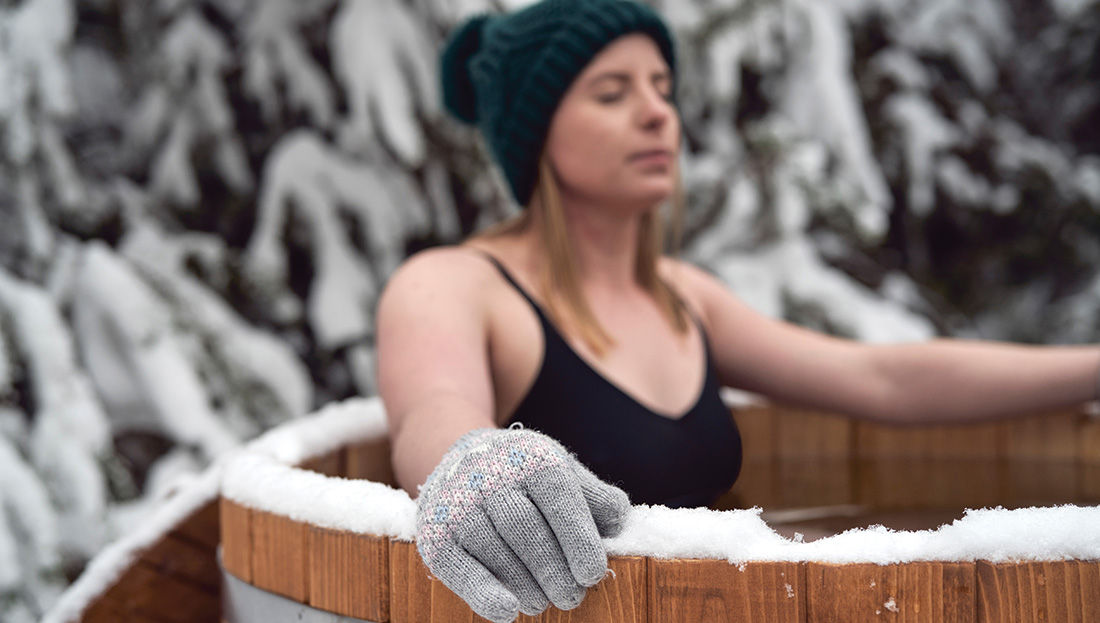
For some people (most people? nearly all people?), the idea of rolling out of bed in the morning and jumping into a cold bath sounds like the worst possible start to their day. But for Joe Nafziger, a San Diego–based marketing and advertising consultant, that has been his daily routine for months now. Before he’s eaten breakfast or even had a cup of coffee, Nafziger heads into his backyard and spends three minutes neck-deep in a metal tub filled with 100 gallons of cold water.
And he’s not alone in his love for this ritual. Daily cold water immersion (CWI) is a growing trend, with videos of people jumping into anything from an ice bath to the Puget Sound going viral on TikTok and other social media. Now, there are important distinctions to be made among CWI, ice baths and polar plunges, but the point is, people are putting themselves through this type of thing in increasing numbers.
The obvious question here is, why?
CWI Defined
Before we get to the reasons for doing this, it’s important to first understand exactly what is meant by CWI. The idea of CWI may conjure images of athletes using post-competition ice baths for recovery or of Kevin Hart conducting shivering interviews on his streaming TV show, but the water used for CWI is not usually ice-filled or nearly that cold.
Nafziger’s setup is pretty typical. He has a 100-gallon livestock trough that he leaves covered in his backyard. The ambient temperature cools the water overnight to within a few degrees of 50° F (10° C), which is the approximate temperature used in most of the research on CWI. Of course, his location in Southern California means his ambient temps may be dramatically different from yours if you live in the Midwest, for example. Nafziger says that while he sometimes adds ice to bring the temperature down in the summertime, he has friends in colder locales who have to use dumbbells to break up the layer of ice that forms overnight on their tub during the winter.
The exact temperature isn’t all that important, but it’s vital to understand that you and your clients don’t have to plunge neck-deep into icy waters to get the benefits described below. The water should be cold, but not that cold.
The Benefits of CWI
CWI has long been understood as an effective means of recovering after athletic competition. ACE-sponsored research conducted by Lance Dalleck, PhD, and his team at the High Altitude Exercise Physiology Program at Western Colorado University, evaluated the effects of CWI on physical performance. Specifically, they looked at the impact of CWI of different durations and after different lengths of time post-exercise. They found that there wasn’t necessarily an optimal duration or timing, as all of the protocols, which you can read about at the link above, were equally effective at enhancing recovery.
Importantly, this research found that CWI did not diminish long-term training adaptions, which is one of the concerns associated with CWI—that future athletic performance is adversely affected by post-workout CWI. Dr. Dalleck explains that while inflammation (which CWI reduces) is typically thought of as a bad thing, it initiates the signaling pathway that ultimately leads to protein synthesis and the making of more mitochondria, which are two favorable training adaptations that exercisers are seeking to achieve. Though Dr. Dalleck’s research did not find this to be the case, the fear for some athletes is that post-workout CWI will diminish inflammation and hamper those benefits.
There is robust research showing that CWI is beneficial for recovery, as it helps reduce muscle soreness and inflammation. What’s interesting about daily CWI routines like the one Nafziger follows, according to Dr. Dalleck, is that it is not necessarily partnered with exercise, as the individual may work out later on or maybe even not at all that day.
While there is not much research specifically evaluating daily CWI (as opposed to post-workout CWI), there is a general understanding of how this type of stressor can positively impact the human body. “Environmental stress,” explains Dr. Dalleck, “is another type of stressor that can be beneficial to your body. So, cold exposure, heat exposure, altitude exposure—there is a wealth of research that the environmental stress and all of the different pathways that get upregulated, oftentimes lead to, on the whole-body level, markers that are favorable to better health.”
Interestingly, there are considerable mental health benefits to CWI, as well. In fact, Nafziger says that, while he definitely feels less soreness and fatigue now that he’s committed to daily CWI, it’s the psychological boost he values most. Because you’re so singularly focused on the sensations your body is enduring, you have to be in the moment, he explains. “It’s almost like serenity for me. It’s three minutes of meditation.”
“I love how it feels,” Nafziger continues. “It’s invigorating. It makes me feel like I had a conquest for the day.” The positivity he feels after CWI lifts his mood in a way that carries him forward into his day.
What the Research Says
Comparing the claims made in popular media to the evidence is challenging, as the research often explores very specific populations and CWI protocols. People—blog writers, TikTokers and other CWI advocates—will sometimes take leaps of faith that those results carry over to the general population. Yes, CWI seems to provide benefit across both physical and mental health but be sure not to oversell its powers to your clients. The evidence is scant for claims like weight loss, an enhanced immune system, cured anxiety, blood sugar regulation and countless other benefits touted on the internet.
Here is a quick rundown of some of the evidence supporting CWI:
- CWI slows the inflammatory response and reduces delayed-onset muscle soreness in untrained individuals performing resistance exercise.
- CWI decreases pain, stress, anxiety and depression, while increasing joint mobility, physical activity and quality of life among individuals with gout arthritis.
- CWI significantly improves mood in young, fit and healthy individuals.
- CWI leaves participants feeling more active, alert, attentive, proud and inspired, and less distressed and nervous, as it increases the interaction between networks in the brain.
- CWI seems to reduce and/or transform body adipose tissue, as well as reduce insulin resistance and improve insulin sensitivity. This may protect against cardiovascular disease and obesity, as well as other metabolic diseases.
Tips for Getting Started With CWI
There are no hard and fast rules when it comes to doing CWI. Much of the research looks at 10- to 20-minute soaks, but those studies have been primarily concerned with athletic performance and recovery. Nafziger’s three-minute soaks may not be enough to optimize those physical outcomes but are enough to elicit the mood boosting and psychological benefits he experiences.
You or your clients may want to start with a shorter soak, then build up the duration from there, if desired and appropriate for the established goals.
As for the moment of actually lowering your body into the water, Nafziger suggests people approach the experience with a sense of calm, rather than fear or apprehension. “It’s so much about the breath,” he says. People are often tense and short of breath during their initial CWI sessions, but that gets better with time. You have to get into the mindset that, it’s not even cold—just get in and breathe.
Nafziger likens the sensation of being submerged in cold water to how you might feel when doing intermittent fasting. While the cold can feel a bit overwhelming during your initial sessions, he says, “After a while, you don’t think about it being cold. You just think about it being a sensation, just like if you’re going to do intermittent fasting. At first, you feel like, ‘I’m hungry and that means I have to eat.’ After a while, it’s just something you’re feeling, but you may not be eating for another three hours. Like hunger, the cold becomes just a sensation that you learn to deal with.”
Once the session is over, it’s important to move the body and get the blood flowing by performing some squats, running in place or doing some stretching. You might follow that by jumping into a hot tub or warm shower.
Finally, be sure to take care of the water between soaks by following manufacturer guidelines (if you have an electric, self-cooling tub), or by doing some basic maintenance if you are using a simple trough. Nafziger agitates the water daily, makes sure it gets some sunshine every few days and sprinkles in a pinch of chlorine every 10 days or so. He changes the water out every three to four weeks and keeps it covered when it’s not in use.
Final Thoughts
Think back to the last time you used a public hot tub, like those at a hotel or on a cruise ship. There is always prominent signage nearby telling members of some populations to consult with their doctors before use, including older adults, pregnant women and people with certain conditions, including heart disease, diabetes and high or low blood pressure. Dr. Dalleck says those same warnings would likely be posted if there were such a thing as public cold-water baths.
Therefore, Dr. Dalleck encourages health coaches and exercise professionals to be conservative with widespread recommendations. Just because you or some of your clients have found benefit from CWI, that doesn’t mean it’s appropriate for all clients. CWI elicits physiological responses such as spikes in both heart rate and blood pressure, so encourage your clients to check with their doctors before adding CWI to their routines, just to be sure there are no concerns or contraindications.
Finally, it’s important to highlight the fact that CWI doesn’t have to be done daily to be effective, so there’s no need to feel like you have to commit to such a strict routine. “There are going to be people who are drawn to doing it daily and having that daily routine,” says Dr. Dalleck, “but doing new things and changing things up is also helpful for our bodies, mentally and physically.”





 by
by 


